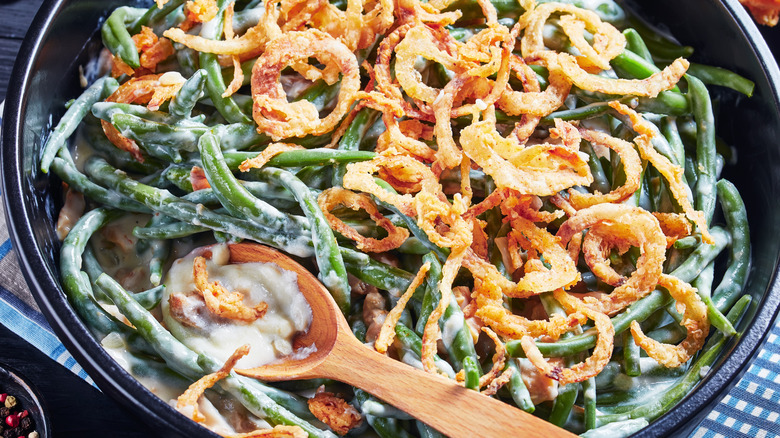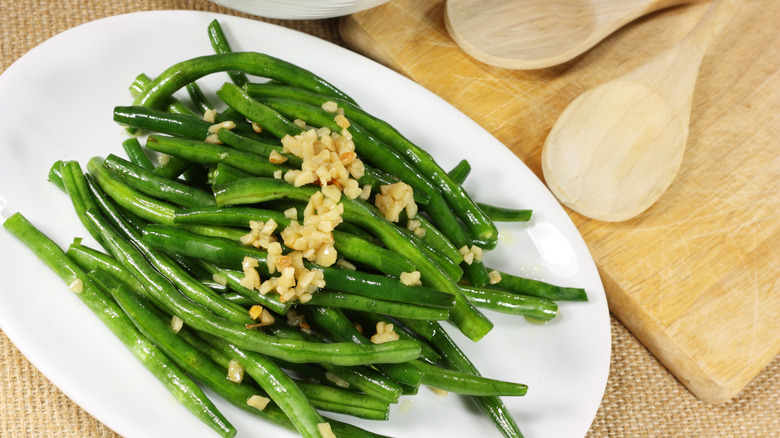Green Beans Vs. French Green Beans: What's The Difference?
The culinary world is full of all sorts of products that are similar but distinct from each other for various reasons. Nowhere is this more true than in vegetables; you've got white cabbage versus red cabbage, broccoli versus cauliflower, and all the varieties of lettuce under the sun, just to name a few. But there's also a difference that comes down to one ingredient being seen as a fancy version of the other: Green beans versus French green beans, or haricot verts.
Chances are, you've heard of haricot verts on fancy restaurant menus, but you might never have prepared them yourself. They sure sound like a fancy professional chefs-only ingredient. But the truth is, they're quite a lot like the green beans you're used to — just with a few key differences. The two aren't harvested quite the same, and while their purpose in cooking is similar, you don't want to prepare them the same, either.
What are green beans?
Look, you probably know what green beans are; chances are you've eaten them before. Green bean casserole topped with crispy onions is a Thanksgiving staple, tempura fried green beans, or even just green beans cooked simply with rosemary and thyme make perfect appetizers; there are all sorts of things you can do with green beans. Whether fresh, frozen, or from a can, one way or another, you've had these before.
Technically, both the green beans you're used to and the fancier haricot verts are green beans, so calling the type you're used to "green beans" is a bit of a misnomer. Specifically, the kind you've probably had many times is a variety known as Blue Lake beans. Blue Lake beans are probably the most popular variety in America and were named after their place of origin: The Blue Lake District in California. Sure, there are other types of standard green beans on the market, but that's the most common one.
What are haricot verts?
Simply put, whatever you call them, the vegetable in question is just a French type of green bean. Both green beans and French green beans are technically the same species; they're cultivars of the common bean (phaseolus vulgaris), which is a member of the Fabaceae family. But their perception — at least in America — couldn't be more different.
French green beans are typically harvested much earlier than other varieties of green bean, when the beans are younger; their peak season is summer, when you're more likely to encounter them at farmer's markets. Because of this, they're typically seen as more delicate and tender than other varieties, which leads to them appearing a lot more on high-end restaurant menus. French green beans may be similar to green beans, but their perception among both diners and chefs is very different.
Green beans stand up to longer cooking times
The most significant difference between the two is that you don't want to cook them the same way. Blue Lake beans (or most other varieties you're familiar with) are shorter, thicker, and a whole lot hardier; not only can you cook them for a lot longer, but there's much more of a margin for error while you do so. Generally, green beans cook in about 12 minutes.
By contrast, haricot verts are noticeably skinnier and longer. This difference in physical proportions pays significant dividends because thinner cuts of things will usually cook faster than thicker cuts because heat doesn't have to penetrate as far into them to get the cooking process going; it's just basic physics. As such, French green beans are much more delicate and must be treated with a little more care, with significantly shorter cooking times: Only about half the cooking time of regular green beans at six minutes.
Haricot verts are seen as being more tender and flavorful
Because haricot verts are harvested earlier than other varieties of green beans, it's believed that they are both more tender and more flavorful than plain old Blue Lake green beans. This is somewhat of a matter of opinion, though, as a lot of that comes down to how you cook either of them. Regardless, the perception of their tenderness and their flavor profile does lead to French green beans tending to be a little bit more expensive than their standard Blue Lake counterpart (and let's be honest, being named something fancy like "haricot verts" doesn't hurt).
Whether you're working with green beans or French green beans, both are excellent veggies, not just for special occasions but for an everyday meal. If you've never worked with haricot verts, you should try it sometime; just be sure to treat them right.




